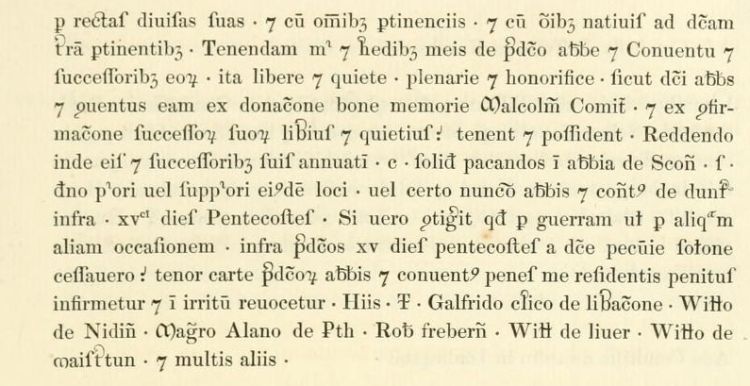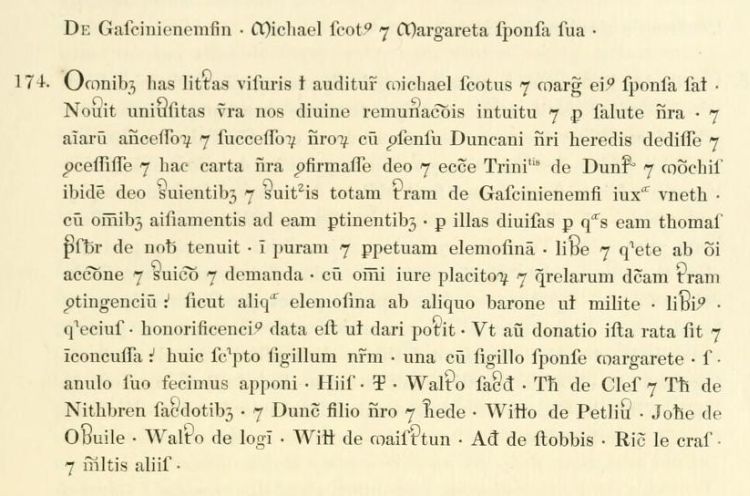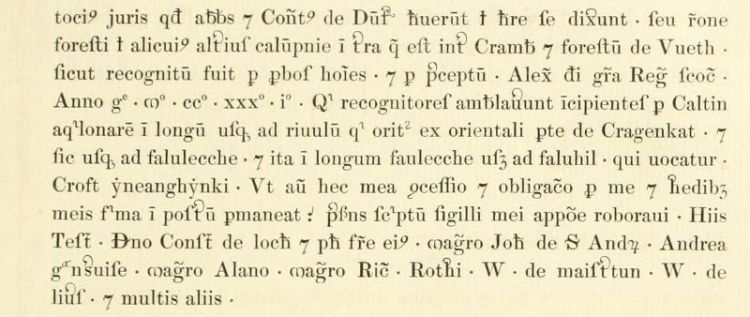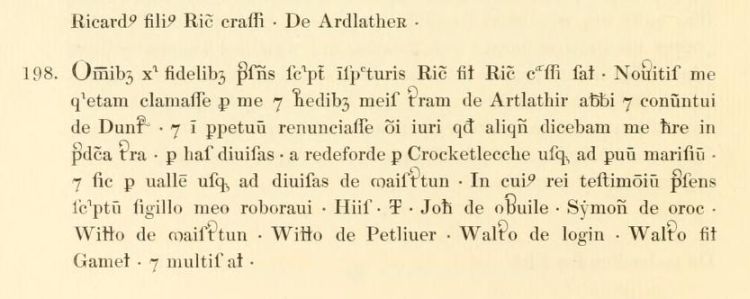William of Masterton (fl 1225-1240)
The First Masterton?
There are a number of very early sources between approx 1215 and 1230 that cite William of Masterton. Willelmo de Maistertun is listed as a witness to a charter that A.A.M. Duncan deduces would have predated 1236. The charter is referred to in a letter of 1323 relating to access to the lands for Dunfermline Abbey. It is unlikely, although not impossible, that this William who was witnessing charters around this time, with a confident date of 1231, could be the same William (son of Hugh), who is recorded in 1272, and so they are listed separately. On the basis of closer proximity, it is assumed that William, son of Hugh, is the same William who signed the Ragman Roll in 1296. Some 13th Century references to William of Masterton are reproduced below.
William de Maistertun Dunf. Reg. no. 150; 1230-1236 [dates approximate].
Registrum de Dunfermelyn
1230-1236(approx)


reproduced from Registrum de Dunfermelyn, pp 86,87. Bannatyne Club, Edinburgh, 1842.
William de Maistertun Dunf. Reg. no. 174 - Charter dated 1215-1231 [dates approximate].
Registrum de Dunfermelyn
1215-31 (approx)

reproduced from Registrum de Dunfermelyn, page 99. Bannatyne Club, Edinburgh, 1842.
William de Maistertun Dunf. Reg. no. 175 - Charter dated 1215-1231 [dates approximate].
Registrum de Dunfermelyn
1215-31 (approx)
.jpg)
reproduced from Registrum de Dunfermelyn, page 99. Bannatyne Club, Edinburgh, 1842.
William de maistertun Dunf. Reg. no. 193 - Charter dated 1231.
Registrum de Dunfermelyn
1231


reproduced from Registrum de Dunfermelyn, pages 108,109. Bannatyne Club, Edinburgh, 1842.
Registrum de Dunfermelyn
1230-1240

reproduced from Registrum de Dunfermelyn, page 112, Bannatyne Club, Edinburgh, 1842.
Regesta Regum Scottorum
The Acts of Robert I, 1306-29
234: Letter recording that Dunfermline abbey obtained entry to the lands at Moulin (Perthshire) which had been granted at feu-ferm to David de Hastings;
David [de Strathbogie] is now forfeited.
Scone, 25 July or subsequent days 1323.
Robertus Dei gracia rex Scottorum omnibus pprobis hominibus tocius terre sue salutem. Accedens in pleno parliamento nostro tento apud Sconam solempniter in festo sancti Jacobi apostoli cum contiuacione dierum sequencium anno Domini millesimo CCCmo xxiii Robertus abbas de Dunfermelyn nomine suo nomineque sui conuentus quandam litteram conuencionalem inter Dauid de Hastyngys ex parte vna et abbatem et conuentum de Dunfermelyn predecessores suos ex altera super terris de Molyn Petdufdy Petmaldoic' Balcone Petmacdufgylle factam et sigillo ipsius Dauid consignatam non cancellatam non abolitam nec in aliqua sui /parte/ viciatam coram nobis et consilio nostro exhibuit et ostendit, cuius tenor talis est: Omnibus ad quos presens scriptum peruenerit Dauid de Hastyngys salutem.........
...Hiis testibus, Galfrido clerico de liberacione, Willelmo de Nydyn, magistro Alano de Pert, Roberto Frebern, Willelmo de Liuer, Willelmo de Maistertun et multis aliis.....
In quorum omnium testimonium sigillum nostrum presentibus precepinus apponi. Dat' et act' apud Sconam in parliamento nostro predicto anno Gracie suprascripto.
NOTES. text partly supplied from Dunfermline Registrum, no 365, p. 150. The MS is obliterated by gall-stains for one-third of a column.
RUBRIC. De Molyn.
SOURCE. NLS, MS Adv. 34.1.3a, fo. xxv (in a hand of the earlier xiv cent.).
PRINTED. Dunfermline Registrum, no. 365; APS i, 481.
REGISTERED. Index 698 (in the form of a minute of parliament).
COMMENT. The agreement with David de Hastings contained in this text must have been made before 1236 when Geoffrey, clerk of the liverance, became a bishop. This
David de Hastings became Earl of Atholl by a marriage which produced no male heir and the right forfeited in 1314 cannot have belonged to a man of that name.
It passed through the female line to the earls of Atholl (as the phrase to be quoted shows), and the original of this letter read, I suggest: Et quia David
de Strathbogie predictas Atholie terras...forisfecit...This is the only emendation of Hastyngys to Strathbogie which is necessary in the text, and it is
supported by the following points:
(a) the text does not read Et Quia dictus David de Hastyngys; i.e. a new David is introduced here.
(b) 'the same David' (i.e. the new one) held the lands 'before he forfeited himself', in the way in which 'the said David de Hastings' had held; the surname
Hastings is necessary here because the new David has intervened and he had a different surname.
See nos 98, 136, 181.
Regesta Regum Scottorum
Volume V: Acts of Robert I
Archibald A.M. Duncan
Edinburgh University Press, Edinburgh, 1988
p 503-504.
The Place-Names of Fife
by Simon Taylor with Gilbert Markus
MASTERTOWN [Dunfermline parish] Settlement; National Grid Ref NT121849; (accurate); OS Pathfinder Sheet 394; Elevation 70 metres; South West Facing
(William of) Maistertun c.1225 x 1231 Dunf. Reg. no. 174
usque ad diusas de Maistertun 1230 x 1240 Dunf. Reg. no. 198 [as far as the marches of Mastertown]
(William of) Maistertun 1230 x 1240 Dunf. Reg. no. 198
(William of) Maystertun 1272 Dunf. Reg. no. 319
(William de) Maistertun 1278 Dunf. Reg. no. 86
(William of) Meistreton 1296 Inst. Pub.
Sources:
Dunf. Reg. Registrum de Dunfermelyn, Bannatyne Club 1842.
Inst. Pub. Instrumenta Publica sive Processus super Fidelitatibus et Homagiis Scotorum Domino Regi Angliae Factis 1291-96, Bannatyne Club 1834 [Ragman Roll].
Taylor and Markus define "Mastertown" (as it became) as 'The estate of the master', the eponymous master being Master Ailric the mason, fl. before 1153, presumably one of those in charge of building work at Dunfermline Abbey. It was given to Dunfermline Abbey by King Malcolm IV on the day of David I's funeral (24 May 1153) (RRS i no. 112).
We can only speculate on William's origins and how he came to occupy the lands of Masterton, but there may be some clues in contemporary events in 13th Century Scotland. We can deduce that William acquired, or was granted leave to occupy, the estate lands from Dunfermline Abbey some time after 1153. His grandson (?) William, son of Hugh of Masterton, was seen to be sufficiently eminent to be asked to swear fealty to Edward I of England in 1296 (Inst. Pub.). So, the Mastertons in mid 13th Century were landed gentry of some stature, in favour with the King of Scots, (sufficently so to be obliged to sign the "Ragman Roll") and occupying lands formerly owned by the King and, later, one of Scotland's major religious foundations.
After the reign of David I (1124-1153) came Malcolm IV (1153-1165) who was succeeded by William I (1165-1214) then Alexander II (1214-1249) and Alexander III (1249-1286). What kind of people were in favour with the Scottish kings' courts at that time?
Ditchburn and Macdonald describe the court as "peopled by the king's counsellors and immediate retainers, men who exercised considerable influence or who were, at any rate, closely linked with the exercise of royal power. The composition of the king's household varied in personnel, but on the basis of charter evidence it mainly consisted of men of Anglo-French stock in the twelfth and thirteenth centuries, with 'native' appearances more irregular. As well as being cosmopolitan, the twelfth-century court was also a highly itinerant institution...and many royal rights were rendered in kind and consumed as the household moved around the kingdom. Just as the personnel attending the court tended increasingly to be 'foreigners', so the geographical location in which the king was to be found was, from the time of David I, mostly inclined to a heartland which was non-Gaelic. Favourite locations of the MacMalcolm kings varied from reign to reign, but the undoubted general inclination was towards the southern and eastern lowlands. This was the area that was most subject to the influences from the Anglo-French settlers.
..from the time of David I the king's retainers, closest companions and advisers inhabited a largely Anglo-French cultural world. An early thirteenth-century English chronicler was able to state, although perhaps not with total accuracy, that the kings of Scotland actually regarded themselves as Frenchmen and had reduced the Scots to servitude. Later, as Anglo-French incomers and native aristocrats intermingled, this sense of division was much less pronounced."
It's possible that William and Hugh were descendants of the saxon Ailric, but that does not fit well with the lands being returned to Dunfermline Abbey in 1153. A more reasonable deduction might be that William (or a close ancestor) was granted the lands of Masterton under royal patronage of Malcolm IV, William I or Alexander II, and that (since native magnates would already have their own lands) William, or his ancestor, was an incomer from the French influx into England and Scotland after the Norman invasion. When he settled in Masterton, he then became "William of Masterton". His son then became "Hugh of Masterton" and so the line began.
Sources:
RRS i Regesta Regum Scottorum vol. i (Acts of Malcolm IV) ed. G.W.S. Barrow, Edinburgh 1960.
Dunf. Reg. Registrum de Dunfermelyn, Bannatyne Club 1842.
Inst. Pub. Instrumenta Publica sive Processus super Fidelitatibus et Homagiis Scotorum Domino Regi Angliae Factis 1291-96, Bannatyne Club 1834 [Ragman Roll].
Taylor and Markus, The Place-Names of Fife. Volume One. West Fife between Leven And Forth. Simon Taylor with Gilbert Markus (Shaun Tyas, Donington, 2006).
Ditchburn and Macdonald, Medieval Scotland, 1100-1560; in The History of Scotland ed R.A. Houston and W.W.J. Knox. Penguin, 2001